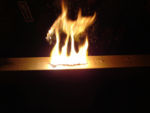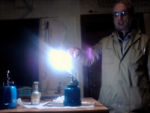Magnesium
| Magnesium | |||||||||||||||||||||||||
|---|---|---|---|---|---|---|---|---|---|---|---|---|---|---|---|---|---|---|---|---|---|---|---|---|---|

| |||||||||||||||||||||||||
| General Info | |||||||||||||||||||||||||
| Atomic Symbol | Atomic symbol::Mg | ||||||||||||||||||||||||
| Atomic Number | Atomic number::12 | ||||||||||||||||||||||||
| Atomic Weight | Atomic weight::24.3050 g/mol | ||||||||||||||||||||||||
| Chemical series | Alkaline earth metals | ||||||||||||||||||||||||
| Appearance | silvery-white 
| ||||||||||||||||||||||||
| Group, Period, Block | 2, 3, s | ||||||||||||||||||||||||
| Electron configuration | [Ne] 3s2 | ||||||||||||||||||||||||
| Electrons per shell | 2, 8, 2 
| ||||||||||||||||||||||||
| CAS number | CAS number::7439-95-4 | ||||||||||||||||||||||||
| Physical properties | |||||||||||||||||||||||||
| Phase | solid | ||||||||||||||||||||||||
| Density | [[Density::1.738 g·cm−3 g/ml]] | ||||||||||||||||||||||||
| Melting point | Melting point::923 K | ||||||||||||||||||||||||
| Boiling point | Boiling point::1363 K | ||||||||||||||||||||||||
| Isotopes of Magnesium | |||||||||||||||||||||||||
| |||||||||||||||||||||||||
| All properties are for STP unless otherwise stated. | |||||||||||||||||||||||||
Magnesium is an alkaline earth metal, and exists in row 3 and column 2 of the periodic table of the elements. Magnesium has a grayish-white appearance, and is highly flammable when it comes in contact with certain other elements. Magnesium is hard to come by, but it is one of the most abundant elements on earth. Magnesium has many uses because of its many usable characteristics. Magnesium is also essential for every living cell to accumulate, because without it, it couldn't exist.
Properties
Magnesium, an alkaline earth metal, has a metallic, grayish-white blush and is highly combustible. When the magnesium burns it produces a magnificent, bright, white light. It is very dangerous when ignited, because of the high temperatures, and is hard to extinguish once ignited.
Magnesium will react with water, producing almost unnoticeable bubbles on its surface, although the reaction will occur more rapidly if powered or when the temperature of the water is greater than room temperature.
Magnesium has a an extremely high melting point standing at 648.8°C; Magnesium ductility and malleability is fairly well when heated.[1]. When in its natural state it has the appearance of a hexagonal, crystalline configuration. Magnesium also is a base since it reacts with most any acidic substance, thus the source of the product "Milk of Magnesia".
Magnesium's electron configuration is [Ne]3s 2 and in it's valence electron shell consists of 2 electrons.
History
Magnesium can be found, in high concentration, in sea water. In 1618, an English farmer was tending to his herd of cows, and took them to a watering well. He tried to get the cows to drink, but the cows refused to drink because the herd knew that the water had a bitter taste. He found out that this water contained Epsom salts, which caused bitterness in the water. Word was spread about Epsom salts, a natural curing product for cuts and scratches. Soon, chemists of the day discovered that Epsom salts contained an isotope of magnesium, magnesium sulfate [2]. Joseph Black was the chemist to first determine if magnesium was actually a element, but it was first isolated by Sir Humphrey Davy, in 1755, and adapted in coherent form by Bussy [3]. Davy first wanted to name the newly discovered element magnium, but magnesium is the name now used. Magnesium was named after the Greek word "Magnesia", which happens to be a district of Thessaly[4].
Occurrences
Magnesium is fairly abundant compared to most of the elements, being the 8 th most abundant element on earth and is also incorporated in the earth's crust, making up 2%of its weight. It is the third highest element concentrated in sea water, too [5]. Being an alkaline earth metal also makes it an element that cannot exist with out being combined with another. Even though there is a large accumulation of magnesium, it is pretty hard to come by. It can only be obtained through a process called electrolysis. Electrolysis is a process of isolation, by isolating a substance through and electrical process. Magnesium can also be obtained through various ores or minerals, such as: magnesite, dolomite, etc.
Uses
Magnesium, as a metal, is the third most frequently used metal for constructional purposes, compared to other important metals such as steel and aluminum. Magnesium, if compared to another element metal, would be mostly like aluminum because both are light and sturdy. These characteristics are good qualities for car manufacturers to obtain, thus, magnesium was used in some car production. Additionally, it was used in German aerospace in W.W. II (World War 2) mainly because of its light, but sturdy composition. Missiles hard outer shell were made mainly out of magnesium metal because of this physical property, too. Other uses for magnesium metal include: pencil sharpeners, fire-starters, and magnesium bands. Another use for magnesium would be in the category of household, electrical appliances, such as: cell phones, computers/laptops, cameras, etc.
Because of magnesium's notorious white, blinding light, it was used as a flash for those antiquated, old-fashioned cameras to light up the surrounding area to take a clear picture. Also, due to it's magnificent, white light it was used as a flare. Magnesium is highly flammable so it was used in pyrotechnics and incendiary bombs [6].
Dietary magnesium can be used as a medicine, such products are Milk of Magnesia (Magnesium Hydroxide) and Epsom salts (Magnesium Sulfate). Others include Magnesium Chloride and Magnesium Citrate [7].
It is also a great alloying helper, especially when combined with aluminum, sturdying the mechanical, fabrication, and welding properties of this alloy [8].
Health Related
Not only is Magnesium fairly abundant on earth, but it is the fourth most abundant mineral in the human body and is needed for a healthy living style. Respectively, nearly half of the magnesium inside our bodies is found in the tissue of our bones. The rest of this essential mineral is primarily located in various vital organs of the body, or could be found in cell tissue. Magnesium is essential for a properly functioning body, mainly because it is required for more than 300 biochemical reactions that occur in the anatomy of a human. Just like calcium it helps fortify the structure of our sturdy bones, magnesium also accomplices the bodies various muscles such as: normal muscle contraction and a steady heart beat. Magnesium also aids in keeping the body’s immune system up and running. Magnesium has been said by scientists that it plays an important part in preventing many different types of disease. Dietary magnesium can be found mainly in one of two places. Either people can take it through a supplement or find it in teeming food sources. The best source of magnesium, in dietary form, can be found in simple vegetables. Chlorophyll cells are where most magnesium saturated substances can be found in a vegetable. Nuts and whole grains are also a good source to find magnesium [9].
Isotopes
- Main Article: Isotope
Magnesium-26 is a stable isotope that is very similar to the element aluminum. Large amounts 26Mg have been found in the research of some carbonaceous chondrite meteorites. The forming of 26Mg is due the decay of its parent 26Al. The main isotopes of magnesium are 24Mg, 25Mg, and 26Mg. The atomic mass of 24Mg is 23.985, its natural abundance is 78.99%, and its half-life is stable. The atomic mass of 25Mg is 24.986, its natural abundance is 10.00%, and its half-life is stable. The atomic mass of 26Mg is 25.983, its natural abundance is 11.01%, and its half-life is stable. Magnesium isotopes 27Mg and 28Mg are also common isotopes of magnesium but they are not quite as stable as magnesium isotopes 24Mg, 25Mg, and 26Mg; 27Mg has a half-life of 9.45 minutes and 28Mg has a half-life of 21 hours.
| nuclide symbol |
Z(p) | N(n) | isotopic mass (u) |
half-life | nuclear spin |
representative isotopic composition (mole fraction) |
range of natural variation (mole fraction) |
|---|---|---|---|---|---|---|---|
| excitation energy | |||||||
| 19Mg | 12 | 7 | 19.03547(27) | 1/2-# | |||
| 20Mg | 12 | 8 | 20.018863(29) | 90.8(24) ms | 0+ | ||
| 21Mg | 12 | 9 | 21.011713(18) | 122(2) ms | (5/2,3/2)+ | ||
| 22Mg | 12 | 10 | 21.9995738(14) | 3.8755(12) s | 0+ | ||
| 23Mg | 12 | 11 | 22.9941237(14) | 11.317(11) s | 3/2+ | ||
| 24Mg | 12 | 12 | 23.985041700(14) | STABLE | 0+ | 0.7899(4) | 0.78958-0.79017 |
| 25Mg | 12 | 13 | 24.98583692(3) | STABLE | 5/2+ | 0.1000(1) | 0.09996-0.10012 |
| 26Mg | 12 | 14 | 25.982592929(30) | STABLE | 0+ | 0.1101(3) | 0.10987-0.11030 |
| 27Mg | 12 | 15 | 26.98434059(5) | 9.458(12) min | 1/2+ | ||
| 28Mg | 12 | 16 | 27.9838768(22) | 20.915(9) h | 0+ | ||
| 29Mg | 12 | 17 | 28.988600(15) | 1.30(12) s | 3/2+ | ||
| 30Mg | 12 | 18 | 29.990434(9) | 335(17) ms | 0+ | ||
| 31Mg | 12 | 19 | 30.996546(13) | 230(20) ms | 3/2+ | ||
| 32Mg | 12 | 20 | 31.998975(19) | 86(5) ms | 0+ | ||
| 33Mg | 12 | 21 | 33.005254(21) | 90.5(16) ms | 7/2-# | ||
| 34Mg | 12 | 22 | 34.00946(25) | 20(10) ms | 0+ | ||
| 35Mg | 12 | 23 | 35.01734(43)# | 70(40) ms | (7/2-)# | ||
| 36Mg | 12 | 24 | 36.02300(54)# | 3.9(13) ms | 0+ | ||
| 37Mg | 12 | 25 | 37.03140(97)# | 40# ms [>260 ns] | 7/2-# | ||
| 38Mg | 12 | 26 | 38.03757(54)# | 1# ms [>260 ns] | 0+ | ||
| 39Mg | 12 | 27 | 39.04677(55)# | <260 ns | 7/2-# | ||
| 40Mg | 12 | 28 | 40.05393(97)# | 1# ms | 0+ | ||
From: Wkipedia [10]
Gallery
 Browse |
Related References
- Magnesium Wikipedia
- Mineral Supplements NIH
- Magnesium-Mg Chemsoc
- Magnesium-Mg About
- Magnesium ODS
- Magnesium Information Yinon Bentor
- History of Magnesium WebElements
See Also
| ||||||||||||||







